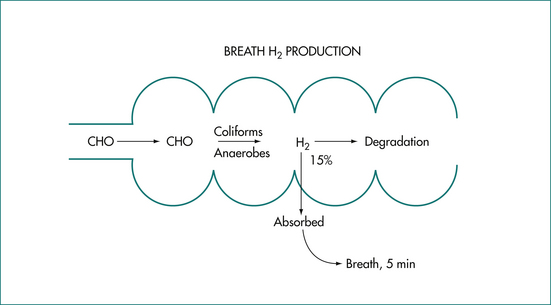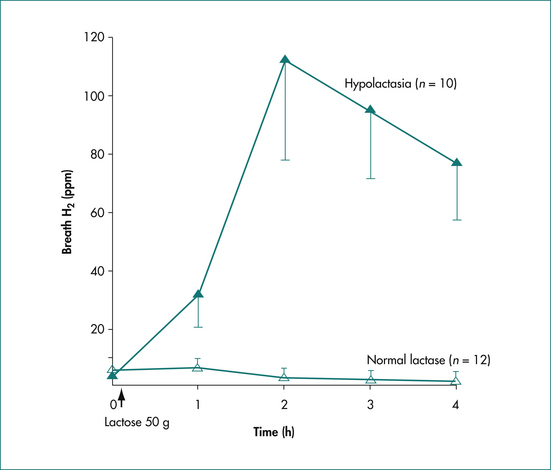8 Wind and gas
Introduction
Many patients present complaining of ‘excessive gas’, which can indicate excessive passage of wind through the mouth or anus, abdominal bloating or audible bowel sounds (borborygmi). In population studies about 20% of individuals report abdominal bloating. The causes of a sensation of excess gas include air swallowing or ingestion of poorly absorbed but fermentable foods such as baked beans, bran or brassica vegetables. Other causes include lactose intolerance (due to lactase deficiency; see ch 18) or malabsorption (e.g. due to coeliac disease, giardiasis or bacterial overgrowth). Functional gastrointestinal disease can also produce a sensation of excessive gas.
History
An accurate history is essential. Determine if the problem is excessive belching (usually due to air swallowing), abdominal bloating or distention, or excessive flatus. Check for evidence of irritable bowel syndrome (IBS), which is characterised by abdominal pain and discomfort with altered bowel habit, a sensation of incomplete rectal evacuation and bloating which is often present in the afternoon. Enquire about the presence of alarm symptoms such as vomiting, bleeding or weight loss and investigate these symptoms if they are present. An adequate dietary history is required. In adults, lactose intolerance is the usual status for non-Caucasians. In general, origin from Northern Europe usually indicates normal lactase levels.
Investigations
X-ray and endoscopy
A plain abdominal x-ray is not normally required. Most patients with bloating and abdominal distention have a normal x-ray. The aim of the x-ray is to confirm the possibility of intestinal obstruction. An upper gastrointestinal endoscopy is required if there are alarm features such as vomiting and weight loss. Mucosal biopsies could be considered to exclude giardiasis or coeliac disease. The lactase level can be quantified on small bowel biopsy specimens.
Breath hydrogen testing for lactose intolerance
Gas production in the human gut is determined by two factors: first, the amount of fermentable substrate that evades digestion in the small bowel and reaches the colon (Fig 8.1); and, secondly, by the individual characteristics of the colonic flora. Lactose intolerance is due to a deficiency of the enzyme lactase in the brush-border membrane of the intestinal villous cell and is manifested by abdominal cramps, borborygmi, bloating, excessive flatus (bacterial fermentation) and diarrhoea (osmotic effect) following milk ingestion. Primary lactase deficiency is genetically determined and lactose intolerance occurs from late childhood in populations who are not of northern European ancestry.
The breath hydrogen (H2) test following a 50 g lactose challenge is a non-invasive, sensitive and specific method to identify subjects with lactase deficiency (Fig 8.2). The subject is prepared by an overnight fast following a meal of meat and rice and avoidance of foods rich in starch and fibre (to reduce baseline H2 levels): smoking is prohibited. A baseline breath test is obtained and then a 50g test load of lactose is administered. Breath samples are obtained at half-hourly intervals for 4 hours. An abnormal result is characterised by breath hydrogen exceeding 20 parts per million over the baseline. Lactose-intolerant patients may experience the usual symptoms listed above. The majority of patients with lactase deficiency have adjusted their diet and generally avoid symptoms associated with lactose-containing foods. Management is by the use of commercial milk products containing lactase, hard and mature cheeses (minimal residual lactose) and yoghurt (auto-digesting).
Breath hydrogen testing for bacterial overgrowth of the small intestine
The syndrome of bacterial overgrowth of the small intestine is characterised by the presence of diarrhoea, malabsorption and weight loss. Potential causes include altered anatomy (e.g. a blind loop associated with a Billroth II gastrectomy) and altered motility (e.g. scleroderma or intestinal pseudo-obstruction). Confirmation of the diagnosis is by demonstration of increased microbial numbers (over 105 organisms/mL) in the proximal small intestine. Alternative, non-invasive techniques use the metabolic action of the bacteria. These indirect diagnostic tests include measurement of the production of H2 after exposure of a fermentable substrate (e.g. glucose or rice flour) to pathologically high levels of intestinal bacteria. A positive test is characterised by a high fasting breath H2 level after dietary preparation as mentioned above and the finding of a rise in breath hydrogen of at least 12 ppm within 2 hours of a 50 g glucose challenge (Fig 8.3).









